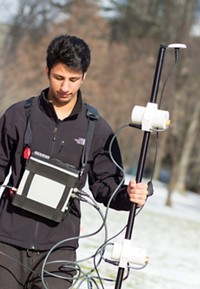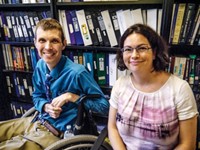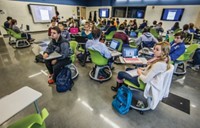Advertisement
Grab your lab coat. Let's get started
Welcome!
Welcome!
Create an account below to get 6 C&EN articles per month, receive newsletters and more - all free.
It seems this is your first time logging in online. Please enter the following information to continue.
As an ACS member you automatically get access to this site. All we need is few more details to create your reading experience.
Not you? Sign in with a different account.
Not you? Sign in with a different account.
ERROR 1
ERROR 1
ERROR 2
ERROR 2
ERROR 2
ERROR 2
ERROR 2
Password and Confirm password must match.
If you have an ACS member number, please enter it here so we can link this account to your membership. (optional)
ERROR 2
ACS values your privacy. By submitting your information, you are gaining access to C&EN and subscribing to our weekly newsletter. We use the information you provide to make your reading experience better, and we will never sell your data to third party members.
Education
Amir Abo-Shaeer
MacArthur Fellow makes engineering education more creative and accessible
by Jyllian N. Kemsley
November 8, 2010
| A version of this story appeared in
Volume 88, Issue 45

At first glance, Amir Abo-Shaeer might not seem that unusual: A mechanical engineer turned high school physics teacher, he’s developed a program within his school to teach students engineering, computer science, and robotics, as well as physics.
But half of the students in his program are girls. He runs the program like a business—with students ordering parts as well as machining them. And he is about to incorporate art. For that innovative approach to education, Abo-Shaeer received one of this year’s MacArthur Fellowships. He’s the second public high school teacher to become such a fellow and the first science teacher to be so honored.
Abo-Shaeer, 38, worked as a mechanical engineer for only a couple of years before returning to his former high school, Dos Pueblos in Santa Barbara, Calif., to teach physics in 2001. In 2002, he established a school-within-a-school known as the Dos Pueblos Engineering Academy. Abo-Shaeer recruited 32 freshmen each year to take a set series of engineering, physics, and computer science classes.
The capstone project for seniors is to build a robot to compete in the FIRST (For Inspiration & Recognition of Science & Technology) Robotics Competition. For the past two years, the Dos Pueblos robotics teams have won regional championships. At the world championships, they’ve won the Motorola Quality Award for the best-designed robot.
Key to the students’ success, Abo-Shaeer says, is that the robotics class is run like a business, with him as chief executive officer. That approach starts when he recruits and accepts eighth-graders into the program. He looks for a mix of talents and interests to form a group that he thinks will work well together. He particularly likes to bring in kids who haven’t always wanted to be engineers—especially girls.
In his recruiting talks, Abo-Shaeer speaks bluntly about the cultural messages that science and engineering aren’t for girls. “Other people try to sugarcoat this stuff and gloss over it,” Abo-Shaeer says. “I say that they’re 13 or 14 years old and this whole field is off the table because of society. Doing the program doesn’t mean that they need to become engineers, but they’re not even giving themselves the opportunity to think about it.”
The result of such straight talk is that 40% of the applications Abo-Shaeer receives are from girls. And those applications are the strongest of the pool—they show maturity and budding leadership qualities that Abo-Shaeer doesn’t see in boys who apply just because building a robot looks like a cool thing to do.
The robotics competition begins each January, so in the fall of their senior year, the students divide into teams to learn the various crafts they’ll need for the competition—things such as programming, computer-aided design, electrical wiring, and machining. By having students specialize, Abo-Shaeer says he’s found that the students seem less overwhelmed by the project and more able to take ownership of their aspects of the robot, as well as see how a design comes together overall. The students also handle more administrative tasks, such as ordering team apparel, procuring parts, and tracking expenses.

Despite the success of the program so far, Abo-Shaeer—who skateboards between classrooms as he oversees training—still isn’t satisfied. Having to work within the limitations and prerequisites of the existing curriculum means that he can’t bring in as broad a student body as he’d like. Space constraints mean that he can’t expand the program. And he’s not achieving something he’s particularly passionate about: changing people’s perceptions of engineering as a mathematically bound, noncreative job.
To achieve these goals, Abo-Shaeer applied for and won a California state grant in 2007 to construct a new building on the Dos Pueblos campus, allowing the program to triple in size starting next fall. He’s also designed a three-year curriculum that incorporates physics, engineering, and art into one sequential course.
The class will be heavily project based, and the projects won’t be cars or other things you might expect from an engineering class. One freshman-year project is a mobile for which students will have to learn about the aesthetics of design, the physics of equilibrium and torque, and the engineering of fabrication. Abo-Shaeer hopes that the projects will serve the dual purposes of attracting students who otherwise wouldn’t consider taking engineering and of making engineering a creative endeavor.
Abo-Shaeer also thinks the approach will have pedagogical benefits. Instead of cramming all of physics into one year, students will progress from easier to more difficult concepts over three years. And because he’ll be able to teach much of the math they’ll need—“engineers aren’t using calculus every day,” he comments—as they go through the sequence, the prerequisite bar will be lowered. He says that the cost of the program is only about $400 more per student than California’s per-pupil funding level of $8,825 for 2009–10.
Abo-Shaeer laments a culture in which scientists and engineers are viewed a certain way and in which it’s mostly their children who pursue those careers. Engineering “is what makes this country move,” he says. By broadening the picture of what engineering is and who does it, he thinks companies will benefit from the wider range of backgrounds and ways of thinking about problems. “But we can only get those people in there if we give them the opportunity to do it,” he says.





Join the conversation
Contact the reporter
Submit a Letter to the Editor for publication
Engage with us on Twitter